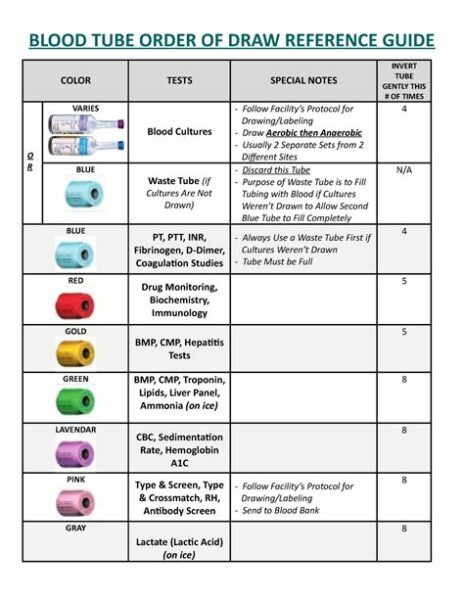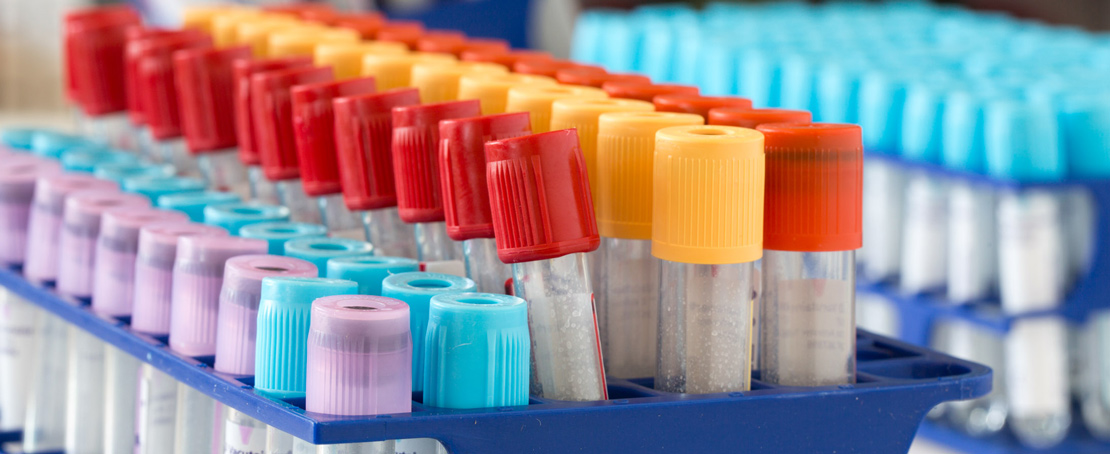When getting blood work done, have you ever wondered why the phlebotomist uses different colored tubes to collect your blood samples? This is because specific tests require different additives or anticoagulants to ensure accurate results. In this blog post, we will explore the order in which blood tubes are drawn and the significance of each color.
1. Red Tube: Serum Tube
The red tube, also known as the serum tube, is the first tube typically used in a blood draw. It doesn’t contain any anticoagulants, allowing the blood to clot and separate from the serum. Serum is the clear fluid that remains after the clot forms, and it is used for various tests, including cholesterol, liver enzymes, and hormones.
2. Lavender Tube: EDTA Tube
The lavender tube contains ethylenediaminetetraacetic acid (EDTA), an anticoagulant that prevents blood from clotting. This tube is commonly used for complete blood count (CBC) tests, as it preserves the blood cells and allows for accurate cell counts and morphology observation. It is also used for blood bank tests.
3. Light Blue Tube: Citrate Tube
The light blue tube contains sodium citrate, which is used as an anticoagulant. It is primarily used for coagulation tests, such as prothrombin time (PT) and activated partial thromboplastin time (aPTT), to evaluate blood clotting abilities and monitor anticoagulant therapy.
4. Green Tube: Heparin Tube
The green tube contains lithium or sodium heparin, which acts as an anticoagulant. It is used for tests that require plasma, such as arterial blood gas analysis, electrolyte tests, and some enzyme assays. Heparin inhibits clotting by activating antithrombin, an enzyme that neutralizes clotting factors.
5. Gray Tube: Glycolytic Inhibitor Tube
The gray tube contains a glycolytic inhibitor, typically sodium fluoride or potassium oxalate. This tube is used for tests that require plasma glucose measurement, as it prevents the breakdown of glucose by glycolysis. It is commonly used in glucose tolerance tests and for monitoring diabetes.
Conclusion
Understanding the order in which blood tubes are drawn is crucial for accurate test results. Each tube color represents a specific additive or anticoagulant necessary for various types of tests. Phlebotomists follow a standardized draw order to ensure the integrity of the samples and the reliability of the results.
Next time you have blood work done, take a moment to appreciate the complexity behind the seemingly simple process of drawing blood. If you have any questions or want to share your experiences, please leave a comment below!
Blood Tube Draw Order
Blood Tube Draw Order ORDER OF DRAW FOR MULTIPLE TUBE COLLECTIONS Blood Culture bottles. 2. Isolator tube. 3. Blue top (3.2% sodium citrate). 4. Red top (no preservative) and Gold top (SST). mlabs.umich.edu The Order of Draw – Center for Phlebotomy Education Do I Have To Follow It? · Blood culture t – drawspaces.com

Order of draw of blood samples affect potassium results without K …
Jun 15, 2021 … Introduction: A specific sequence is recommended for filling blood tubes during blood collection to prevent erroneous test results due to … – pubmed.ncbi.nlm.nih.gov

Order of draw of blood samples affect potassium results without K …
Apr 15, 2021 … Anticoagulant K-EDTA is frequently used as a sample tube anticoagulant for laboratory assays including complete blood count, glycated … – www.ncbi.nlm.nih.gov

ORDER OF DRAW FOR MULTIPLE TUBE COLLECTIONS
Order of Draw for Multiple Tube Collections. When collecting multiple specimens, blood tubes should be drawn in the following order; mix all tubes by … – mlabs.umich.edu
The Order of Draw during Blood Collection: A Systematic Literature …
Feb 7, 2021 … The order of draw is necessary to obtain correct biochemical results. EDTA contamination was not evident in blood samples collected by trained … – www.ncbi.nlm.nih.gov

Modification of Blood Test Draw Order to Reduce Blood Culture …
Aug 22, 2020 … … tube before blood culture bottles (diversion group) or blood cultures first and then lithium heparin tube (control group). All study … – pubmed.ncbi.nlm.nih.gov

Order of Draw
Order of Draw · Blood Culture Tubes or Vials · Coagulation Tubes (Blue-Top Tubes) · Serum Tubes without Clot Activator or Gel (Red-Top tubes) · Serum Tubes with … – www.expresslabidaho.com

The Order of Draw – Center for Phlebotomy Education
Do I Have To Follow It? · Blood culture tubes · Sodium citrate tubes (e.g., blue-stopper) · Serum tubes with or without clot activator, with or without gel … – www.phlebotomy.com
At Home Blood Draw Service Near Me
At Home Blood Draw Service Near Me: Convenient and Reliable Healthcare at Your Doorstep In today’s fast-paced world convenience plays a vital role in our daily lives. Whether it’s ordering groceries online or getting a ride with just a few taps on our smartphones the demand for services that cater t – drawspaces.com

Draw Blood Bruise
Draw Blood Bruise: Understanding Causes Treatment and Prevention Bruises also known as contusions are a common occurrence that most of us have experienced at some point in our lives. These discolored patches on our skin can be a result of various factors but have you ever wondered how bruises actual – drawspaces.com

Phlebotomy tutorial for medical education – WebPath
Syringes – may be used in place of the evacuated collection tube for special circumstances. ORDER OF DRAW. Blood collection tubes must be drawn in a specific … – webpath.med.utah.edu
